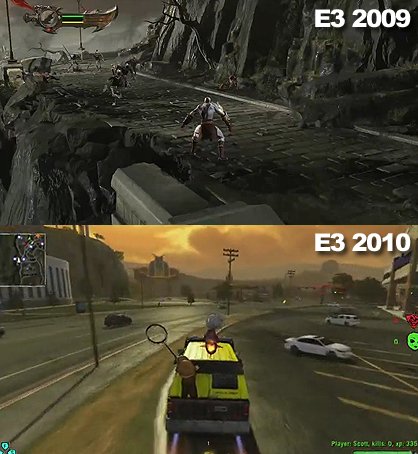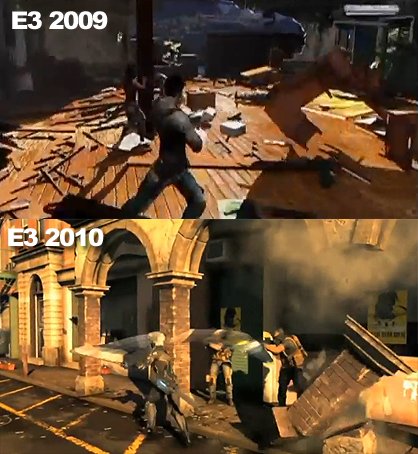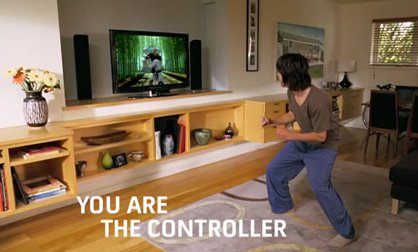E3 2010: Is new tech holding games back?
Comparing last year's E3 to this and feeling sad
This year (in the non-Nintendo press conferences, that is), it was all a bit different. The sense of progression was gone. And I'll tell you why I believe it is: 3D and motion sensitive technology is holding games back.
The traditional lifecycle of a console before the next comes out is about five years. That means this year's E3 would have given us at least an announcement of a new machine, if not a full demonstration of its capabilities. But, perhaps due to the economic climate, instead we've been givenpricey bolt-on augmentations for current-gen tech, which is supposedly going to keep the current crop going for another couple of years at least.
History (or more specifically, Sega) will tell you that add-ons for an existing console certainly does NOT automatically equal success. Sega CD and 32X were expensive, confused customers, diluted a winning brand and proved costly failures. And with loads of devs obediently supporting Kinect and Move, it's stunted the crop of big games that we would usually see at the show.

Above: Which is the better game to end a press conference on?
Just look at Metal Gear Solid Rising. This is a game that does not (so far) feature Kinect or Move support. It's a 'proper' videogame and looks absolutely stunning. In fact, they could have told usit's a launch game for a next-gen machine and we probably still would have cheered the step forward.
It was a trailer comparable to last year's Uncharted 2 demo. Visibly better than anything we've seen before and pushing the medium forward into new territory.

Above: Uncharted 2 (top) and MGS Risingeach had an amazing moment
Weekly digests, tales from the communities you love, and more
But can that be said of any of the new technologies that Sony and Microsoft focused so much time on? Let's have a look:
3D
General consensus is Sony's 3D games look superb. The effect is solid and convincing and everything it should be. That's great, but you only have to look at the game developers' comments to see how restrictive this actually is. With the machine effectively having to render everything twice, the processor load must be phenomenal. Compromises will have to be made. That extra power needed for 3D is power that could have been spent on other aspects of the game.
And what about when you get over the initial wow factor? Killzone 3 as a game looks like being yet another competent shooter. Take away the 3D (and the much-hyped brand name) and I bet you'd be looking at an 8/10 game that's not massively different from its predecessor.

Above: Or was it the other way round? No, definitely that way. Um...
It also costs extra for the consumer, with the price of a TV, the glasses (one expensive pair for everyone in the room) and the games themselves. EA reckon you ought to pay more for 3D games than regular games. Get real – there's no way gamers are going to accept another era of £60 'deluxe' games. PSone had it right - £30 for chart games is affordable, meaning people will buy more, play more and love their console more.
Motion sensitive gaming
Last year, the prospect of 1:1 movement was still relatively new. Nintendo had Wii Motion Plus, but Sony's new demos looked better and seemed to respond better. Then Project Natal (as it was then known) concluded the show andleft us feeling like Nintendo was finished. The big N's most-prized unique selling point was going to be available on every console, in HD. Game Over.

Above: Natal looked great, didn't it? But where are the games like this?
A year later, if you were to look at Nintendo's press conference in isolation, you'd think they've the company had pretty much finished with motion control. The Zelda demo didn't work properly, other new games were more about gameplay than waggle and the 3DS announcement was 100% tilt-free. It's almost as though the motion control ship has sailed, leaving Sony and Microsoft stepping aboard a very shiny, HD Titanic.
The focus on motion from Sony and Microsoft this yearis so intense, itseems to beat the cost of everything else. Sony's 'surprise' announcement to top the show was an underwhelming demo of a game that looks like it belongs on PSN. Microsoft left us downright disturbed by showing us a little girl playing with a make-believe tiger.

Above:Surely acopy of Nintendogs on DS would make her happier?
If the two gaming giants are just starting off on the same path that Nintendo began paving in 2006, we're looking at a potential four years of disillusion from hardcore gamers. If they're serious about 3D and motion control, they have to support it wholeheartedly. Nintendo fanboys may havegiven up on their love(or secretly held out on selling their Wiis in the hope of an E3 like this one)… and there's no reason to think the same can't happen to Xbots and PS fanboys.
If we get a successor to the Wii next year, I bet the focus will no longer be on motion control. Nintendo is looking to the future and appears to have read the market impeccably again.Everyone else is arriving at the end of the party, having spent an awful lot of money on their outfits and crates of booze.If they insist on cracking opena crate andgetting drunk in the emptying room,we gamers might just suffer the hangover.
17 Jun, 2010
Justin was a GamesRadar staffer for 10 years but is now a freelancer, musician and videographer. He's big on retro, Sega and racing games (especially retro Sega racing games) and currently also writes for Play Magazine, Traxion.gg, PC Gamer and TopTenReviews, as well as running his own YouTube channel. Having learned to love all platforms equally after Sega left the hardware industry (sniff), his favourite games include Christmas NiGHTS into Dreams, Zelda BotW, Sea of Thieves, Sega Rally Championship and Treasure Island Dizzy.



